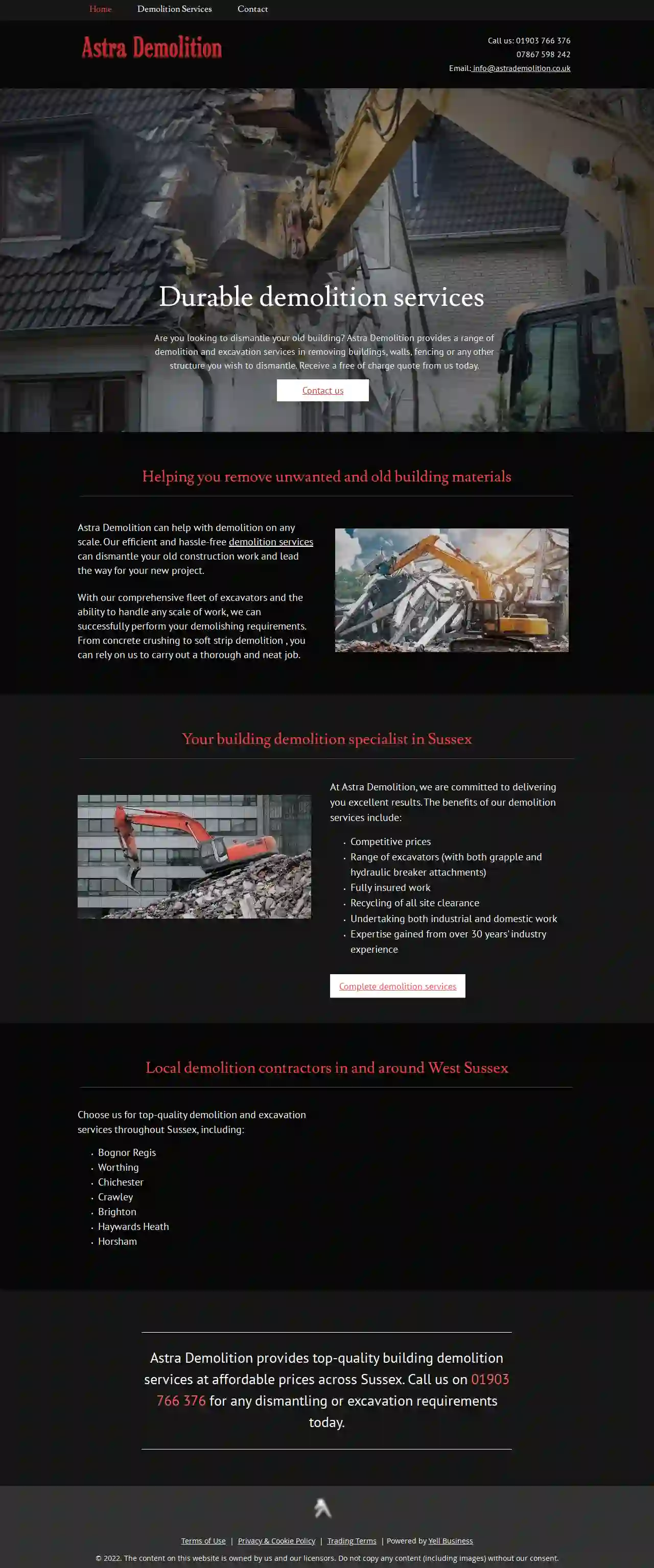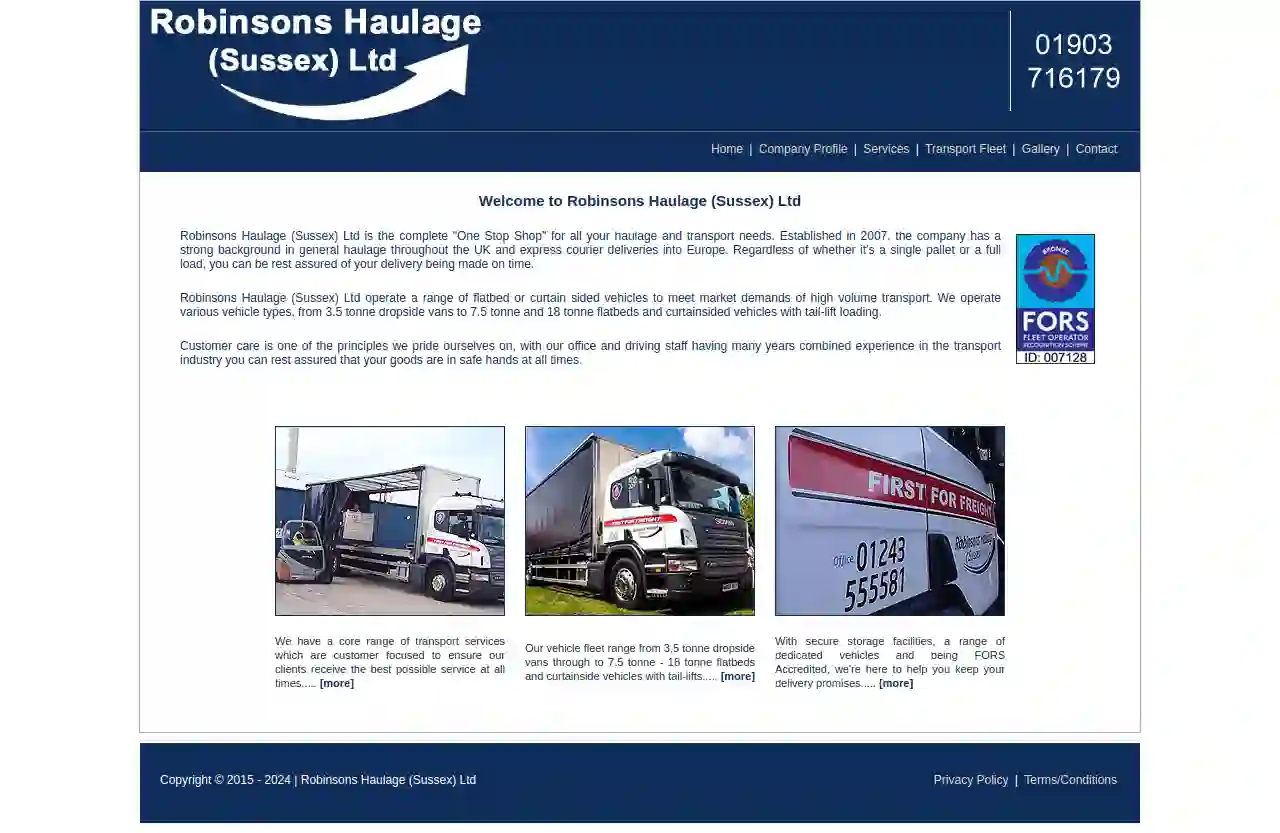Excavation Contractors Felpham
Top Excavation Companies in Felpham
Receive 3 FREE Excavating Contractors quotes for your project today! Compare profiles, reviews, accreditations, portfolio, etc... and choose the best offer.

Central Plant Hire
4.937 reviewsHolmbush Farm, Crawley Road, Holmbush Farm Crawley Road Faygate Horsham West Sussex, Horsham, RH12 4SE, GBCentral Plant Hire is a leading provider of plant and digger hire in West Sussex and Surrey. We offer a wide range of equipment to suit all your needs, from mini diggers to dumpers and attachments. We are committed to providing our customers with the highest quality equipment and service. Our team is experienced and knowledgeable, and we are always happy to answer your questions. We offer competitive rates and flexible hire options to suit your budget. We are proud to be a local business, and we are committed to supporting our community. We are a member of the Construction Industry Federation (CIF) and we are fully insured.
- Services
- Why Us?
- Accreditations
- Gallery
Get Quote
T King & Son Groundwork Ltd
Gentles Lane, Passfield, Liphook, GU30 7RY, GBT. King & Son (Groundworks) Ltd: Your Trusted Groundworks Partner in Hampshire For over 50 years, T. King & Son (Groundworks) Ltd has been a leading provider of groundworks services in Liphook, Hampshire. We've built a strong reputation for delivering exceptional quality and efficiency, earning the trust of countless satisfied customers. Our commitment to excellence is evident in every project we undertake, from residential to commercial groundworks and maintenance. We understand that construction work can be disruptive, which is why we prioritize minimizing disruption and delivering projects on time and within budget. Our team of skilled professionals is dedicated to providing a seamless and hassle-free experience for our clients. Whether you're building your dream home, expanding your business, or need reliable commercial maintenance, T. King & Son (Groundworks) Ltd is your trusted partner. We're committed to exceeding your expectations and delivering results that stand the test of time.
- Services
- Why Us?
- Gallery
Get Quote
JPG groundworks
Worthing, GBAbout JPG JPG Groundworks was established in the year 2000, initially focusing on domestic groundworks and building projects. Over the past decade, we have transitioned our expertise predominantly towards agricultural and estate groundwork projects. This includes the construction of new buildings, building conversions, and comprehensive refurbishments. We take pride in our modern fleet of well-maintained excavators, dumpers, rollers, and other essential equipment. Our commitment lies in delivering a competitive and professional package tailored to meet the specific needs of each client. Our service area encompasses West Sussex, Hampshire, Surrey, and parts of East Sussex.
- Services
- Why Us?
- Gallery
Get Quote
Arundels Construction
54 reviews13 The Cape, Littlehampton, West Sussex, BN17 6PL, GBArundels Construction Ltd Based in West Sussex, Arundels Construction Ltd has built a lasting reputation as a company of general and new home builders. With high-end services and an attractive pricing policy that can’t be beaten by any of our competitors, we transform properties in Bognor Regis, Chichester, Worthing and locations across the surrounding areas. About Arundel Builders With a sizeable portfolio of repeat customers who trust our general and new home builders completely, Arundels Construction Ltd will deliver a stress-free project to exceed your expectations. The procurement of quality materials from a trusted supplier network, coupled with our ability to take on installation and electrical work, has seen our company build a first-class reputation for its standards of workmanship and approach to superior customer service. We carry the required liability insurances, offer guarantees of between 15 and 25 years on our completed work, and have a perfect “10” rating on the Checkatrade website where our own customers review our projects. What Sets Us Apart Where we differ from other builders is in our ability to manage a project from the design stage all the way through to completion. Arundels Construction Ltd can include architectural work, engineering calculations and private building inspections in your package, which we adapt to your personal requirements.
- Services
- Why Us?
- Testimonials
- Gallery
Get Quote
Dancy Building Contractors Limited
55 reviewsUnit 1, The Old Dairy, Steyning, BN44 3DZ, GBDancy Building Contractors: Modern Building, Traditional Values Dancy Building Contractors is a reputable and experienced building company based in Steyning, West Sussex. We are committed to delivering high-quality building services with a focus on traditional values and modern construction techniques. Our team of skilled professionals is dedicated to providing exceptional craftsmanship and customer service, ensuring your project is completed to the highest standards. We understand that building projects can be complex and require careful planning and execution. That's why we take a collaborative approach, working closely with our clients to understand their needs and vision. We provide clear communication, transparent pricing, and a commitment to delivering projects on time and within budget. Whether you're planning a home extension, loft conversion, or a complete new build, Dancy Building Contractors has the expertise and experience to handle your project with confidence. We are proud of our reputation for quality, reliability, and customer satisfaction. Contact us today to discuss your building project and let us help you bring your vision to life.
- Services
- Why Us?
- Gallery
Get Quote
Astra Demolition
51 reviewsWorthing, GBDurable demolition services Are you looking to dismantle your old building? Astra Demolition provides a range of demolition and excavation services in removing buildings, walls, fencing or any other structure you wish to dismantle. Receive a free of charge quote from us today. Helping you remove unwanted and old building materials Astra Demolition can help with demolition on any scale. Our efficient and hassle-free demolition services can dismantle your old construction work and lead the way for your new project. With our comprehensive fleet of excavators and the ability to handle any scale of work, we can successfully perform your demolishing requirements. From concrete crushing to soft strip demolition, you can rely on us to carry out a thorough and neat job. Your building demolition specialist in Sussex At Astra Demolition, we are committed to delivering you excellent results. The benefits of our demolition services include: Competitive prices Range of excavators (with both grapple and hydraulic breaker attachments) Fully insured work Recycling of all site clearance Undertaking both industrial and domestic work Expertise gained from over 30 years' industry experience Complete demolition services Local demolition contractors in and around West Sussex Choose us for top-quality demolition and excavation services throughout Sussex, including: Bognor Regis Worthing Chichester Crawley Brighton Haywards Heath Horsham Astra Demolition provides top-quality building demolition services at affordable prices across Sussex. Call us on 01903 766 376 for any dismantling or excavation requirements today.
- Services
- Why Us?
- Gallery
Get Quote
Stonehouse Groundworks Ltd
52 reviewsLancaster’s farm, Littleworth lane, Lancaster’s farmLittleworth lanePartridge greenHorsham, Horsham, RH13 8EJ, GBWelcome to Stonehouse Groundworks & Construction Stonehouse Construction Services is a highly reputable and well established groundworks company providing a comprehensive groundworks, civil engineering and demolition service to commercial, industrial and private customers throughout the South East. Started by Jake Lovelock, Stonehouse Groundworks Ltd was trading from 2004 and incorporated in 2007. At Stonehouse Groundworks & Construction Ltd all plant is owned and maintained by ourselves, giving us flexibility to deal with any size project in house. Our trained staff draw on years of experience within the industry. At Stonehouse Groundworks & Construction Ltd holds comprehensive £10M public liability insurance, giving all clients peace of mind.
- Services
- Why Us?
- Accreditations
- Gallery
Get Quote
JATA Construction (South East Division) LTD
1b Paardeberg Road, Bodmin, PL31 1EY, GBResolute precision Your journey towards a perfect future begins with us. Precision isn’t just a buzzword in our vocabulary… It’s ingrained in every nail hammered and every brick laid We don’t just build structures; we forge relationships, collaborating with you every step of the way. At JATA, compromise isn’t in our dictionary but collaboration is. We promise unparalleled value, delivering nothing short of first-rate craftsmanship. With a seasoned team of highly skilled tradesmen, we waste no time in turning your dreams into realities. Challenges? We devour them and thrive on producing pragmatic, no-nonsense, solutions. We create, one resolute step at a time.
- Services
- Why Us?
- Accreditations
- Testimonials
- Gallery
Get Quote
M.G Construction Limited
Findon Court, Findon Road, Findon, BN14 0RA, GBYOUR LOCAL BUILDING AND CONSTRUCTION SPECIALISTS MG Construction offers reliable services of high quality at an affordable price. With more than 20 years of experience, we cover everything from new home builds to hard landscaping. If you need a dependable team of builders to assist on a project in the West Sussex area, look no further than MG Construction. Located in Worthing, we can easily access all parts of the county including Lancing and Steyning. Leave structural work, property refurbishments and home renovations in our capable hands, or add extra living space to a home with one of our property extensions, loft conversions or garage conversions. The choice is always up to you. MG Construction offers a project management service where we handle all aspects of the job from the conceptual stages through to handover. We can supply your project with builders, carpenters and all manual trades, which helps us maintain tight control over who is onsite and what happens onsite. All work undertaken complies with the current UK Building Regulations, and we trade with appropriate levels of employer and public liability insurance. Please contact us to arrange a survey, consultation and written quotation.
- Services
- Why Us?
- Testimonials
- Gallery
Get Quote
Robinsons Haulage Sussex Ltd
4.913 reviewsArea 3, Bairds Business Park, Hobbs New Barn, Bairds Business Park Hobbs New Barn Gravetts Lane, Climping West Sussex, Climping, BN17 5RX, GBAbout Robinsons Haulage (Sussex) Ltd Robinsons Haulage (Sussex) Ltd is a well-established haulage and transport company, founded in 2007. We've built a strong reputation for providing reliable and efficient services throughout the UK and Europe. Whether you need to move a single pallet or a full load, you can trust us to deliver on time and with the utmost care. We've grown from a single 3.5 tonne van to a fleet of vehicles ranging from 3.5 tonne dropside vans to 7.5 tonne and 18 tonne flatbeds and curtainsided vehicles with tail-lift loading. This allows us to cater to a wide range of transport needs, ensuring we have the right vehicle for every job. Customer satisfaction is at the heart of everything we do. Our team, with years of combined experience in the transport industry, is dedicated to providing exceptional service. We take pride in our commitment to safety and security, ensuring your goods are in safe hands at all times. We're proud to be FORS (Bronze) Accredited, demonstrating our commitment to safety, efficiency, and environmental responsibility. Our experienced and well-trained staff are committed to providing our clients with the highest level of service, keeping them informed every step of the way.
- Services
- Why Us?
- Accreditations
- Gallery
Get Quote
Over 13,059+ Excavation Contractors in our network
Our excavation providers operate in Felpham and beyond!
ExcavationHQ has curated and vetted Top Excavation Companies in Felpham. Find a reliable business today.
Frequently Asked Questions About Excavation Contractors
- Clearly Define the Scope: Outline the project's goals, including the excavation area, depth, grade, and intended use.
- Obtain Necessary Permits: Research and acquire any required permits from your local authorities.
- Mark Utility Lines: Contact your utility companies to locate and mark underground utilities to prevent damage.
- Communicate with Neighbors: Inform your neighbors about the project's timeline and potential noise or disruptions.
- Prepare the Site: Clear any obstacles, such as vegetation, furniture, or structures, from the excavation area.
- Discuss Safety Protocols: Review safety procedures with the contractor to ensure a safe work environment.
- Determine the Area: Measure the length and width of the area you want to fill. Multiply them to get the area in square feet (or meters).
- Determine the Depth: Measure the difference between the existing grade and the desired grade (how much you need to raise the ground). This is the depth of fill required.
- Calculate Volume: Multiply the area (step 1) by the depth (step 2) to get the volume in cubic feet (or meters).
- Account for Compaction: Fill dirt compacts when it settles, so add 10% to 25% to the calculated volume to account for compaction. The exact percentage depends on the type of fill material.
- Determining Soil Suitability: Assessing whether the soil can support the intended structure or load.
- Recommending Foundation Types: Advising on the appropriate foundation design based on soil characteristics.
- Addressing Drainage and Erosion Issues: Providing solutions to manage water runoff and prevent erosion.
- Evaluating Slope Stability: Assessing the risk of landslides or soil movement on slopes.
- Building on challenging soil types (expansive clay, loose sand, etc.)
- Constructing large or complex structures
- Excavating near slopes or retaining walls
- Addressing drainage or erosion concerns
What should I do before excavation starts?
How do I calculate how much dirt I need for fill?
What is a soil engineer, and do I need one?
What is the difference between excavation and grading?
Excavation: Primarily involves removing earth or other materials from a site. It's about digging down and creating space.
Grading: Focuses on shaping and leveling the ground to a specific slope or elevation. It's about adjusting the existing terrain.
For example, you might excavate a foundation and then grade the surrounding area to ensure proper drainage and a level surface for landscaping.
What should I do before excavation starts?
- Clearly Define the Scope: Outline the project's goals, including the excavation area, depth, grade, and intended use.
- Obtain Necessary Permits: Research and acquire any required permits from your local authorities.
- Mark Utility Lines: Contact your utility companies to locate and mark underground utilities to prevent damage.
- Communicate with Neighbors: Inform your neighbors about the project's timeline and potential noise or disruptions.
- Prepare the Site: Clear any obstacles, such as vegetation, furniture, or structures, from the excavation area.
- Discuss Safety Protocols: Review safety procedures with the contractor to ensure a safe work environment.
How do I calculate how much dirt I need for fill?
- Determine the Area: Measure the length and width of the area you want to fill. Multiply them to get the area in square feet (or meters).
- Determine the Depth: Measure the difference between the existing grade and the desired grade (how much you need to raise the ground). This is the depth of fill required.
- Calculate Volume: Multiply the area (step 1) by the depth (step 2) to get the volume in cubic feet (or meters).
- Account for Compaction: Fill dirt compacts when it settles, so add 10% to 25% to the calculated volume to account for compaction. The exact percentage depends on the type of fill material.
What is a soil engineer, and do I need one?
- Determining Soil Suitability: Assessing whether the soil can support the intended structure or load.
- Recommending Foundation Types: Advising on the appropriate foundation design based on soil characteristics.
- Addressing Drainage and Erosion Issues: Providing solutions to manage water runoff and prevent erosion.
- Evaluating Slope Stability: Assessing the risk of landslides or soil movement on slopes.
- Building on challenging soil types (expansive clay, loose sand, etc.)
- Constructing large or complex structures
- Excavating near slopes or retaining walls
- Addressing drainage or erosion concerns
What is the difference between excavation and grading?
Excavation: Primarily involves removing earth or other materials from a site. It's about digging down and creating space.
Grading: Focuses on shaping and leveling the ground to a specific slope or elevation. It's about adjusting the existing terrain.
For example, you might excavate a foundation and then grade the surrounding area to ensure proper drainage and a level surface for landscaping.